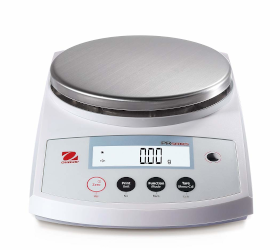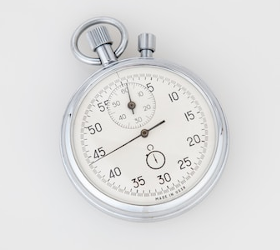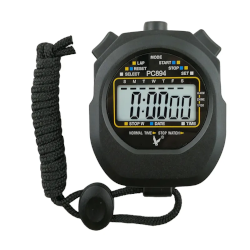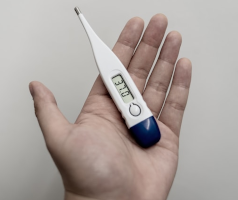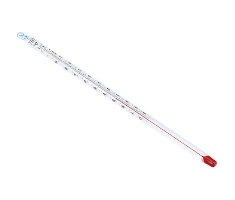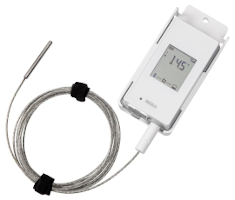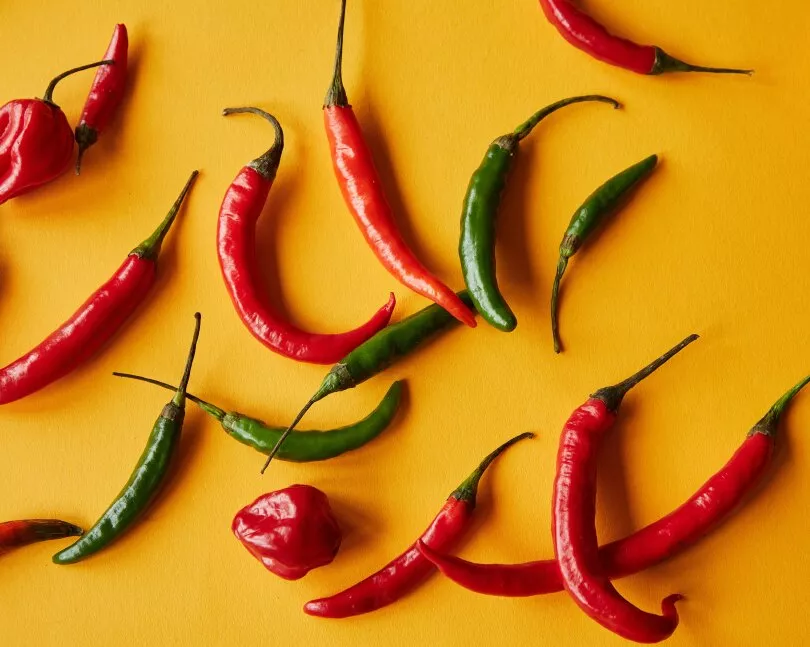Measurement And Experimental Techniques
In this article, we will be covering the following objectives:
- S.I. units for the common physical properties used in the study of Chemistry.
- Name the appropriate apparatus for measuring mass, time, temperature, and volumes of liquids and gases.
- Degree of accuracy for the different apparatus.
The content covered in this article is as per the requirements of the Secondary 3 Chemistry syllabus in Singapore.
Common physical properties
What are some of the common physical properties used in the study of Chemistry?
| Physical Property | S.I. Unit | Symbol Of S.I. Unit |
|---|---|---|
| mass | kilogram | \(\text{kg}\) |
| time | second | \(\text{s}\) |
| temperature | kelvin | \(\text{K}\) |
| volume | cubic metre | \(\mathrm{m^3}\) |
- The S.I. units (International System of Units) are the standard units adopted to be used internationally around the world, especially during scientific studies. It allows scientists to communicate scientific information easily and to avoid any confusion when measuring.
Measuring Mass
|
Image Credit: Alibaba - Beam Balance |
Image Credit: Amazon - Electronic Balance |
- The S.I. unit for mass is the \(\text{kilogram (kg)}\). However, sometimes we may also use other forms of units such as tonne or gram.
\(1 \text{ tonne } = 1000 \text{ kg}\)
\(1 \text{ kg } = 1000 \text{ g}\)
- The 2 apparatus used for measuring mass of a substance are:
- beam balance
- electronic balance
- The electronic balance is most commonly used in laboratories because it allows the user to measure the mass of a substance very quickly and accurately.
- The electronic balance can measure the mass of a substance with an accuracy of up to \(\pm\; 0.01 \text{ g}\) (two decimal places).
Measuring Time
|
Image Credit: Stanislav - unsplash.com |
Image Credit: alibaba - alibaba.com |
- The S.I. unit for time is \(\text{second (s)}\). Other units for time include \(\text{minute (min)}\) and \(\text{hour (h)}\).
\(\begin{align} 1 \text{ hour} &= 60 \text{ mins} \\[2ex] 1 \text{ min} &= 60 \text{ s} \end{align}\)
- The 2 equipment often used to measure time are:
- analogue stopwatch
- digital stopwatch
- There are 2 scales in the analogue stopwatch. The bigger (outer) scale is called the main dial, which measures the time in seconds. The smaller (inner) scale is called the secondary dial, which measures the time in minutes. So, combining the readings from the two scales, you will be able to get the reading of the time in minutes and seconds, to an accuracy of \(\pm\; 0.1 \text{ s}\).
The knob at the top of the analogue stopwatch allows you to start, stop, and reset the entire stopwatch.
- In terms of accuracy, the digital stopwatch can provide a more accurate measurement of time than an analogue stopwatch, as the digital stopwatch can measure time up to an accuracy of \(\pm\; 0.01 \text{ s}\).
Measuring Temperature
|
Image Credit: Winel Sutanto - unsplash.com |
Image Credit: Monotaro - monotaro.sg |
|
Image Credit: Vaisala - vaisala.com |
|
- The S.I. unit for temperature is \(\text{kelvin (K)}\). However, the more frequently used unit for temperature is degree \(\mathrm{Celsius \;(^{\circ}C)}\).
- To convert \(\text{kelvin}\) into degree \(\text{Celsius}\):
\(\mathrm{\textbf{Temperature in K } = \textbf{ Temperature in } ^\circ C + 273}\)
- The 3 common apparatus used to measure temperature are:
- Digital Thermometer
- Alcohol Thermometer
- Temperature Sensor Connected To A Data Logger
- Accuracy of an alcohol thermometer:\(\mathrm{ \pm\; 0.5 \;^\circ C}\)
- A temperature sensor connected to a data logger can also be used to measure temperature, where it provides a more accurate reading than the alcohol thermometer. The temperature sensor is placed in the chemical solution or the environment where the temperature is to be measured, and the data logger receives and captures the data. This device, not only provides more precise results, it also allows the user to study the temperature change of a substance over a period of time.
Measuring Volume (Liquids)
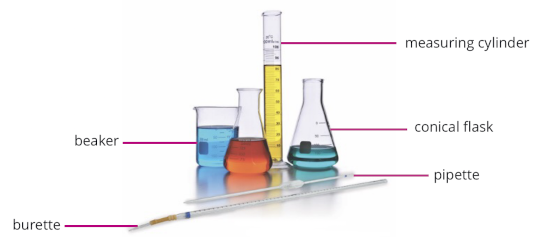
Image Credit: Chemistry Matters textbook
- The S.I. unit for volume is the cubic metre (m\(^3\)).
- The apparatus used in measuring the volume of a liquid are:
- beaker
- conical flask
- measuring cylinder
- pipette
- burette
- In terms of accuracy in measuring the volume of a liquid, beakers and conical flasks are the least accurate. They are commonly used to measure approximate volumes of liquids. Measuring cylinders are more accurate than a beaker and a conical flask.
- A measuring cylinder can measure volumes of liquids to the nearest 0.5 cm\(^3\).
- The pipette is slightly more accurate compared to measuring cylinders. It is used to measure a fixed volume of a liquid, such as 10.0 cm\(^3\), 20.0 cm\(^3\) and 25.0 cm\(^3\).
- The most accurate apparatus for the measurement of a liquid’s volume is a burette. It can measure out the volume of a liquid to the nearest 0.05 cm\(^3\). A burette is widely used while performing the titration experiment, when the user needs to deliver different volumes of a liquid or solution.
Reading Of The Volume Of Liquids
How should we read the volume of liquids?
- A meniscus is a curved surface formed when a liquid or a solution is placed in a container. When reading the volume of the liquid, we must always hold the container at eye level and read off the scale at the meniscus of the liquids to avoid parallax error.
- When the meniscus is a concave meniscus (as shown in the image on the left), we will read off the scale at the bottom of the meniscus. On the other hand, when the meniscus is a convex meniscus (as shown in the image on the right), we will read off the scale at the top of the meniscus.
- A concave meniscus most likely occurs with water and glass, while a convex meniscus most likely occurs with mercury and glass.
Try It Yourself
Question 1:
Which of the following can be used to measure a volume of 25.0 cm\(^3\) of a solution?
- 25 cm\(^3\) beaker
- 25 cm\(^3\) measuring cylinder
- 25 cm\(^3\) pipette
- 50 cm\(^3\) burette
Answer:
(B), (C), and (D)
Explanation:
The degree of accuracy of the volume of solution that we want to measure is in 1 decimal place.
A beaker cannot be used because it does not provide accurate measurement of volumes of liquids.
A measuring cylinder can be used because its degree of accuracy is 0.5 cm\(^3\).
A pipette is also possible because it measures a fixed volume of liquid such as 25.0 cm\(^3\) and is very accurate.
A burette is the most accurate apparatus with a degree of accuracy of 0.05 cm\(^3\), thus it is also suitable.
Measuring Volume (Gases)
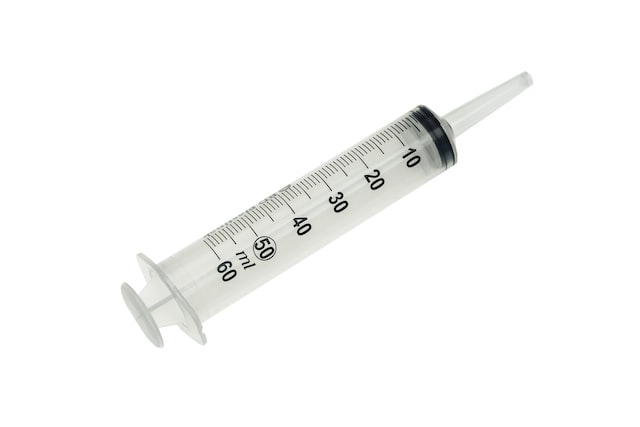
Image Credit: Ed Cijs - unsplash.com
The apparatus used to measure the volume of gas is a gas syringe. The gas syringe measures a maximum volume of 100 cm\(^3\).
Reading the Volume of Gases
How should we measure the volume of a gas?
- A gas syringe is made up of a barrel and a plunger. At the start of an experiment, the plunger is first pushed in fully to expel any gas present in the syringe.
- As the gas (e.g. produced in a chemical reaction) enters the gas syringe and occupies the space at the front of the barrel, the plunger is being pushed outwards.
Try It Yourself
Question 1:
The diagram below shows a section of a measuring cylinder:
At which position should the eye be placed to obtain an accurate reading of the liquid volume?
Answer:
(3)
Explanation:
The meniscus in the diagram is a concave meniscus. Hence, we should read off the scale at the bottom of the meniscus, and at eye level.
Question 2:
Which of the following pairs correctly shows the physical property of its S.I. unit?
physical property S.I. unit
- mass \(g\)
- time \(h\)
- temperature \(^{\circ}\text{C}\)
- volume \(m^3 \)
Answer:
(D)
Explanation:
The S.I. unit for mass is kilogram (\(kg\)), instead of grams (\(g\)).
The S.I. unit for time is second (\(s\)), instead of hour (\(h\)).
The S.I. unit for temperature is kelvin (\(K\)), instead of degree Celsius (\(^{\circ}\text{C}\)).
Question 3:
Which of the following apparatus is the most suitable to deliver a fixed volume of 25.0 cm\(^3\) hydrochloric acid solution into a beaker?
- beaker
- burette
- measuring cylinder
- pipette
Answer:
(D) pipette
Explanation:
As the term ‘fixed volume’ has been used in the question, a pipette will be the most appropriate apparatus for the measurement of this volume (25.0 cm\(^3\)) of hydrochloric acid solution.
Question 4:
Which of the following apparatus is the most suitable to dilute 2.0 mol/dm\(^3\) of sodium hydroxide solution with 50 cm\(^3\) of water?
- beaker
- burette
- measuring cylinder
- pipette
Answer:
(A) beaker
Explanation:
As there is no decimal place in the volume of water (50 cm\(^3\)) needed to be measured, it implies that the measurement does not need to be very accurate and precise. So, we can simply use the beaker here.
Question 5:
Which of the following apparatus is the most suitable to dispense 28.4 cm\(^3\) of dilute sulfuric acid into a conical flask?
- beaker
- burette
- measuring cylinder
- pipette
Answer:
(B) burette
Explanation:
A burette can accurately measure and deliver the volume of a liquid to the nearest 0.05 cm\(^3\). Thus, it is the most suitable for dispensing 28.4 cm\(^3\) of dilute sulfuric acid.
A beaker does not allow for accurate measurement of the volume of a liquid. A measuring cylinder can only measure volumes to the nearest 0.5 cm\(^3\), instead of 0.1 cm\(^3\). A pipette can only measure fixed volumes of liquids such as 20.0 cm\(^3\) or 25.0 cm\(^3\).
Question 6:
Which of the following apparatus is the most suitable to collect 25.6 cm\(^3\) of carbon dioxide gas from a reaction?
- burette
- conical flask
- gas syringe
- pipette
Answer:
(C) gas syringe
Explanation:
As the gas, carbon dioxide, has to be collected here, the gas syringe is the most suitable answer.
Question 7:
The reaction between solutions X and Y releases heat. A student was told to test this statement by mixing a fixed amount of 10.0 cm\(^3\) of each of the two solutions and measuring the temperature.
Which of the following pairs of apparatus should the student use?
- burette and electronic stopwatch
- burette and thermometer
- measuring cylinder and electronic stopwatch
- pipette and thermometer
Answer:
(D) pipette and thermometer
Explanation:
A pipette is used to measure out fixed volumes of liquids such as 10.0 cm\(^3\), 20.0 cm\(^3\) or 25.0 cm\(^3\). Since the question specifies that a fixed volume of 10.0 cm\(^3\) of each of the two solutions is needed, a pipette is the most suitable. To measure temperature, we have to use a thermometer.
Conclusion
This article on measurement and experimental techniques is written to provide deeper insights into the apparatus required to measure the few common physical properties used in the study of Chemistry. The apparatus we choose for an experiment is dependent on the physical quantity as well as the accuracy of the measurement that we want to take.
| Continue Learning | |
|---|---|
| Kinetic Particle Theory | Elements, Compounds and Mixtures |
| Separation and Purification | Atomic Structure |
| Measurement and Experimental Techniques | Ionic Bonding |
| Covalent Bonding | Writing Chemical Equations |
| Oxidation and Reduction | Acids And Bases |
| The Mole | Salts |
| Atmosphere and Environment | Periodic Table |
| Chemical Calculations | Qualitative Analysis |


 SG
SG  VN
VN 

